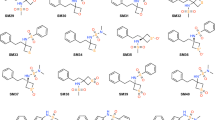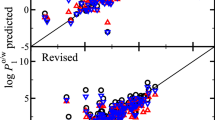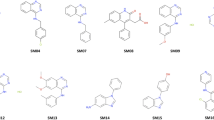Abstract
We applied the solvation models SM8, SM8AD, and SMD in combination with the Minnesota M06-2X density functional to predict vacuum-water transfer free energies (Task 1) and tautomeric ratios in aqueous solution (Task 2) for the SAMPL2 test set. The bulk-electrostatic contribution to the free energy of solvation is treated as follows: SM8 employs the generalized Born model with the Coulomb field approximation, SM8AD employs the generalized Born approximation with asymmetric descreening, and SMD solves the nonhomogeneous Poisson equation. The non-bulk-electrostatic contribution arising from short-range interactions between the solute and solvent molecules in the first solvation shell is treated as a sum of terms that are products of geometry-dependent atomic surface tensions and solvent-accessible surface areas of the individual atoms of the solute. On average, three models tested in the present work perform similarly. In particular, we achieved mean unsigned errors of 1.3 (SM8), 2.0 (SM8AD), and 2.6 kcal/mol (SMD) for the aqueous free energies of 30 out of 31 compounds with known reference data involved in Task 1 and mean unsigned errors of 2.7 (SM8), 1.8 (SM8AD), and 2.4 kcal/mol (SMD) in the free energy differences (tautomeric ratios) for 21 tautomeric pairs in aqueous solution involved in Task 2.






Similar content being viewed by others
References
Bamborough P, Cohen FE (1996) Modeling protein-ligand complexes. Curr Opin Struct Biol 6(2):236–241
Pei J, Wang Q, Zhou J, Lai L (2004) Estimating protein-ligand binding free energy: atomic solvation parameters for partition coefficient and solvation free energy calculation. Proteins 54(4):651–664
Schiffer CA, Caldwell JW, Stroud RM, Kollman PA (1992) Inclusion of solvation free energy with molecular mechanics: alanyl dipeptide as a test case. Protein Sci 1(3):396–400
Kollman P (1993) Free energy calculations: applications to chemical and biochemical phenomena. Chem Rev 93(7):2395–2417
Rivail J-L, Rinaldi DL, Ruiz-Lopez MF (1991) The self-consistent reaction field model for molecular computations in solution. In: Formosinho SJ, Arnaut L, Csizmadia I (eds) Theoretical and computational models for organic chemistry. Kluwer Academic Publishers, Dordrecht, pp 79–92
Tomasi J, Persico M (1994) Molecular interactions in solution: an overview of methods based on continuous distributions of the solvent. Chem Rev 94(7):2027–2094
Hawkins GD, Zhu T, Li J, Chambers CC, Giesen DJ, Liotard DA, Cramer CJ, Truhlar DG (1998) Universal solvation models. In: Gao J, Thompson MA (eds) Combined quantum mechanical and molecular mechanical methods, American Chemical Society, Symposium Series, vol 712, Washington, pp. 201–219
Cramer CJ, Truhlar DG (1999) Implicit solvation models: equilibria, structure, spectra, and dynamics. Chem Rev 99(8):2161–2200
Tomasi J, Mennucci B, Cammi R (2005) Quantum mechanical continuum solvation models. Chem Rev 105(8):2999–3094
Mennucci B, Cammi R (eds) (2008) Continuum solvation models in chemical physics: from theory to applications. Wiley, New York
Hoijtink GJ, de Boer E, van der Meij PH, Weijland WP (1956) Reduction potentials of various aromatic hydrocarbons and their univalent anions. Recueil des Travaux Chimiques des Pays-Bas et de la Belgique 75:487–503
Tucker SC, Truhlar DG (1989) Generalized born fragment charge model for solvation effects as a function of reaction coordinate. Chem Phys Lett 157(1–2):164–170
Still WC, Tempczyk A, Hawley RC, Hendrickson T (1990) Semianalytical treatment of solvation for molecular mechanics and dynamics. J Am Chem Soc 112(16):6127–6129
Marenich AV, Olson RM, Kelly CP, Cramer CJ, Truhlar DG (2007) Self-consistent reaction field model for aqueous and nonaqueous solutions based on accurate polarized partial charges. J Chem Theory Comput 3(6):2011–2033
Marenich AV, Cramer CJ, Truhlar DG (2009) Universal solvation model based on the generalized Born approximation with asymmetric descreening. J Chem Theory Comput 5(9):2447–2464
Marenich AV, Cramer CJ, Truhlar DG (2009) Universal solvation model based on solute electron density and a continuum model of the solvent defined by the bulk dielectric constant and atomic surface tensions. J Phys Chem B 113(18):6378–6396
Tomasi J, Mennucci B, Cancès E (1999) The IEF version of the PCM solvation method: an overview of a new method addressed to study molecular solutes at the QM ab initio level. J Mol Struct (Theochem) 464(1):211–226
Grycuk T (2003) Deficiency of the coulomb-field approximation in the generalized Born model: an improved formula for Born radii evaluation. J Chem Phys 119(9):4817–4826
Storer JW, Giesen DJ, Cramer CJ, Truhlar DG (1995) Class IV charge models: a new semiempirical approach in quantum chemistry. J Comp-Aided Mol Des 9:87–110
Kelly CP, Cramer CJ, Truhlar DG (2005) SM6: a density functional theory continuum solvation model for calculating aqueous solvation free energies of neutrals, ions, and solute-water clusters. J Chem Theory Comput 1(6):1133–1152
Olson RM, Marenich AV, Cramer CJ, Truhlar DG (2007) Charge Model 4 and intramolecular charge polarization. J Chem Theory Comput 3(6):2046–2054
Baldridge K, Klamt A (1997) First principles implementation of solvent effects without outlying charge error. J Chem Phys 106:6622–6633
Marenich AV, Cramer CJ, Truhlar DG (2009) Performance of SM6, SM8, and SMD on the SAMPL1 test set for the prediction of small-molecule solvation free energies. J Phys Chem B 113(14):4538–4543
Zhao Y, Truhlar DG (2008) The M06 suite of density functionals for main group thermochemistry, kinetics, noncovalent interactions, excited states, and transition elements: two new functionals and systematic testing of four M06 functionals and twelve other functionals. Theor Chem Acc 120:215–241
Francl MM, Pietro WJ, Hehre WJ, Binkley JS, Gordon MS, DeFrees DJ, Pople JA (1982) Self-consistent molecular orbital methods. XXIII. A polarization-type basis set for second-row elements. J Chem Phys 77:3654–3666
Hariharan PC, Pople JA (1973) The influence of polarization functions on molecular orbital hydrogenation energies. Theoret Chimica Acta 28(3):213–222
Lynch BJ, Zhao Y, Truhlar DG (2003) Effectiveness of diffuse basis functions for calculating relative energies by density functional theory. J Phys Chem A 107(9):1384–1388
Bryantsev VS, Diallo MS, Goddard WA (2008) Calculation of solvation free energies of charged solutes using mixed cluster/continuum models. J Phys Chem B 112:9709–9719
Lynch BJ, Zhao Y, Truhlar DG (2005) The 6-31B(d) basis set and the BMC-QCISD and BMC-CCSD multicoefficient correlation methods. J Phys Chem A 109(8):1643–1649
Frisch MJ, Trucks GW, Schlegel HB, Scuseria GE, Robb MA, Cheeseman JR, Montgomery JA Jr, Vreven T, Kudin KN, Burant JC, Millam JM, Iyengar SS, Tomasi J, Barone V, Mennucci B, Cossi M, Scalmani G, Rega N, Petersson GA, Nakatsuji H, Hada M, Ehara M, Toyota K, Fukuda R, Hasegawa J, Ishida M, Nakajima T, Honda Y, Kitao O, Nakai H, Klene M, Li X, Knox JE, Hratchian HP, Cross JB, Bakken V, Adamo C, Jaramillo J, Gomperts R, Stratmann RE, Yazyev O, Austin AJ, Cammi R, Pomelli C, Ochterski JW, Ayala PY, Morokuma K, Voth GA, Salvador P, Dannenberg JJ, Zakrzewski VG, Dapprich S, Daniels AD, Strain MC, Farkas O, Malick DK, Rabuck AD, Raghavachari K, Foresman JB, Ortiz JV, Cui Q, Baboul AG, Clifford S, Cioslowski J, Stefanov BB, Liu G, Liashenko A, Piskorz P, Martin KomaromiI, RL FoxDJ, Keith T, Al-Laham MA, Peng CY, Nanayakkara A, Challacombe M, Gill PMW, Johnson B, Chen W, Wong MW, Gonzalez C, Pople JA (2003) Gaussian03, revision E.01. Gaussian Inc., Pittsburgh
MN-GFM (2008) Minnesota gaussian functional module, version 4.1. University of Minnesota, Minneapolis
MN-GSM (2009) Minnesota gaussian solvation module, version 2009. University of Minnesota, Minneapolis
Halgren TA (1996) Merck molecular force field. I. Basis, form, scope, parameterization, and performance of MMFF94. J Comp Chem 17(5):490–519
PCModel, version 9.1 for Windows, 2006, Serena Software, Bloomington, 47402
Adamo C, Barone V (1998) Exchange functionals with improved long-range behavior and adiabatic connection methods without adjustable parameters: the mPW and mPW1PW models. J Chem Phys 108(2):664–676
Easton RE, Giesen DJ, Welch A, Cramer CJ, Truhlar DG (1996) The MIDI! basis set for quantum mechanical calculations of molecular geometries and partial charges. Theor Chim Acta 93(5):281–301
Kelly CP, Cramer CJ, Truhlar DG (2006) Adding explicit solvent molecules to continuum solvent calculations for the calculation of aqueous acid dissociation constants. J Phys Chem A 110(7):2493–2499
Ribeiro RF, Marenich AV, Cramer CJ, Truhlar DG (2009) Solvent dependence of 14N nuclear magnetic resonance chemical shielding constants as a test of the accuracy of the computed polarization of solute electronic densities by the solvent. J Chem Theory Comput 5(9):2284–2300
Katritzky AR, Øksne S, Boulton AJ (1962) The tautomerism of heteroaromatic compounds with five-membered rings—III: further isoxazol-5-ones. Tetrahedron 18(6):777–790
Acknowledgements
This work was supported by the Office of Naval Research under Grant N 00014-05-01-0538, the Army Research Office under Grant US ARMY RES LAB/W911NF09-1-0377, and the National Science Foundation (Grant CHE06-10183 and Grant CHE07-04974). Computational resources were provided by the Minnesota Supercomputing Institute.
Author information
Authors and Affiliations
Corresponding authors
Electronic supplementary material
Below is the link to the electronic supplementary material.
Rights and permissions
About this article
Cite this article
Ribeiro, R.F., Marenich, A.V., Cramer, C.J. et al. Prediction of SAMPL2 aqueous solvation free energies and tautomeric ratios using the SM8, SM8AD, and SMD solvation models. J Comput Aided Mol Des 24, 317–333 (2010). https://doi.org/10.1007/s10822-010-9333-9
Received:
Accepted:
Published:
Issue Date:
DOI: https://doi.org/10.1007/s10822-010-9333-9




